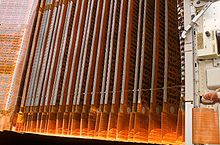Integrated Truss Structure
All truss components were named after their planned end-positions: Z for zenith, S for starboard and P for port, with the number indicating the sequential position.The S0 truss might be considered a misnomer, as it is mounted centrally on the zenith position of Destiny and is neither starboard nor port side.While the bulk of the Z1 truss is unpressurized, it features a Common Berthing Mechanism (CBM) port that connects its nadir to the zenith port of Unity and contains a small pressurized dome that allowed astronauts to connect electrical ground straps between Unity and the truss without an EVA.[4] This MBM is not a port and is not pressurized or electrically powered, but it can be operated with a handheld tool to berth any passive CBM to it.In December 2008, the Ad Astra Rocket Company announced an agreement with NASA to place a flight test version of its VASIMR ion thruster on the station to take over reboost duties.Detailed design, test, and construction of the S1 and P1 structures were conducted by McDonnell Douglas (now Boeing) in Huntington Beach, CA.[9] The P3/P4 truss assembly was installed by the Space Shuttle Atlantis STS-115 mission, launched September 9, 2006, and attached to the P1 segment.Upon its installation, no power was flowing across the rotary joint, so the electricity generated by the P4 solar array wings was only being used on the P4 segment and not the rest of the station.The primary functions of the P3 truss segment are to provide mechanical, power and data interfaces to payloads attached to the two UCCAS platforms; axial indexing for solar tracking, or rotating of the arrays to follow the sun, via the SARJ; movement and worksite accommodations for the Mobile Transporter.Major subsystems of the P4 and S4 Photovoltaic Modules (PVM) include the two Solar Array Wings (SAW), the Photovoltaic Radiator (PVR), the Alpha Joint Interface Structure (AJIS), and Modified Rocketdyne Truss Attachment System (MRTAS), and Beta Gimbal Assembly (BGA).Work to install support brackets for the new arrays on the P6 truss mast cans was initiated by the members of Expedition 64.[13] Work to install and deploy the first two arrays themselves on the P6 brackets was successfully conducted over three spacewalks by Shane Kimbrough and Thomas Pesquet of Expedition 65.[14][15][16] In November and December 2022, astronauts Francisco Rubio and Josh A. Cassada of Expedition 68 installed the second set of brackets and arrays, one each on the P4 and S4 Trusses.[17][18][19][20] In June 2023, astronauts Stephen Bowen and Warren Hoburg of Expedition 69 installed the third set of brackets and arrays, one each on the S6 and S4 Trusses.When in operation, these joints continuously rotate to keep the solar array wings on the outboard truss segments oriented towards the Sun.Each SARJ is 10 feet in diameter, weighs approximately 2,500 pounds and can be rotated continuously using bearing assemblies and a servo control system.[11] The Solar Alpha Rotary Joints contain Drive Lock Assemblies which allow the outer segments of the ITS to rotate and track the Sun.During STS-120 Astronaut Scott Parazynski rode the Orbiter Boom Sensor to repair a tear in the 4B solar array.The first truss segment to be launched was Z1, which was mounted to the Unity module's zenith (facing away from Earth) Common Berthing Mechanism.




















International Space Stationtrussesradiatorssolar arraysaluminiumstainless steelfabricatedHuntington Beach, CaliforniaMichoud Assembly FacilityNew Orleans, LouisianaMarshall Space Flight CenterHuntsville, AlabamaTulsa, OklahomaSpace Station Processing Facilityinvestment castinghot rollingTIG weldingSTS-92control moment gyroscopeplasma contactorsCommon Berthing MechanismSTS-98Ad Astra Rocket CompanyVASIMRion thrusterGravity Field and Steady-State Ocean Circulation ExplorerExpedition 11Sergei K. KrikalevDestiny Laboratory ModuleSTS-110Canadarm2anhydrousammoniaSTS-112STS-113Space Station FreedomreboostSpace Shuttle AtlantisSTS-115STS-116AtlantisSTS-117longeronsEXPRESS Logistics CarrierSTS-118STS-97STS-120STS-119Unity ModuleSpace Shuttle DiscoveryCanadarm-1Canadarm-2Space Shuttle EndeavourElectrical system of the International Space StationRoll Out Solar Arrayenergyphotovoltaic arraysRussianScience Power Platformsiliconphotovoltaic cellsdiodesaccordionGimbalsrotateSpaceX Dragon 2SpaceX CRS-22Expedition 64Shane KimbroughThomas PesquetExpedition 65Francisco RubioJosh A. CassadaExpedition 68Stephen BowenWarren HoburgExpedition 69Night Glider modeLockheed Martinpinionbull gearspace walksSTS-122lithium-ion batterySpace Systems/LoralBoeinglithium-ion batteriesExpedition 50Peggy WhitsonVictor J. GloverMichael S. HopkinsDextregrapple fixturesOrbiter Boom SensorAssembly of the International Space StationDestinyManufacturing of the International Space StationSpace.compublic domainRussian SegmentPrichalRassvetZvezdaUS SegmentColumbusCupolaHarmonyLeonardoQuest airlockTranquilityBishop airlockElectrical SystemEuropean Robotic ArmExternal Stowage PlatformsExPRESS Logistics CarriersInternational Docking AdaptersLife Support SystemMobile Servicing SystemBoom AssemblyPressurized Mating AdaptersStrelaWindow Observational Research FacilityAMS-02ISS-CREAMPK-3 Plus